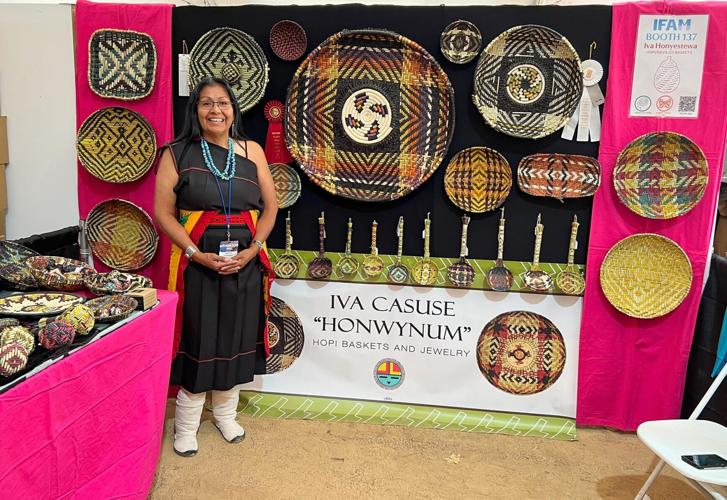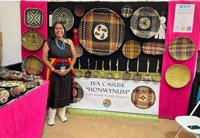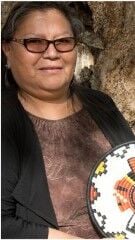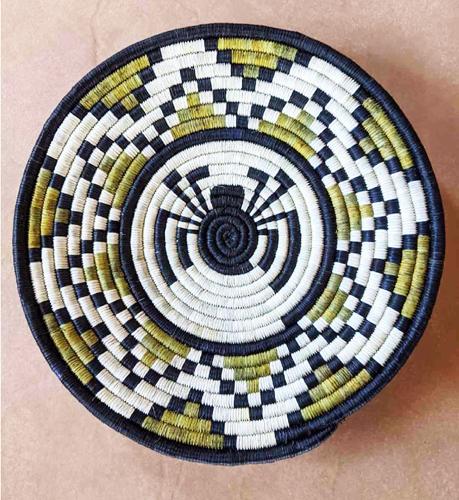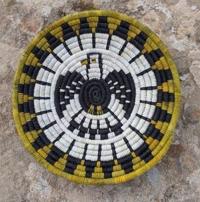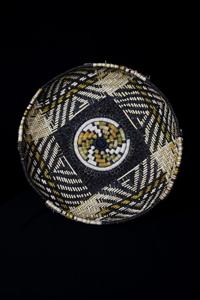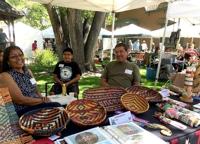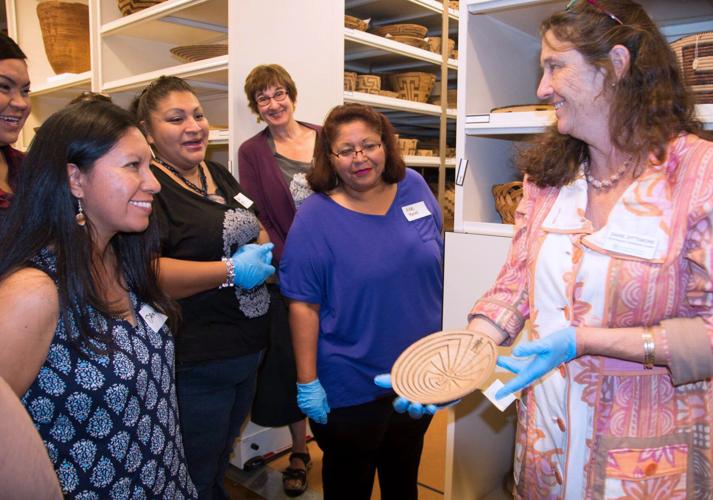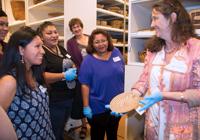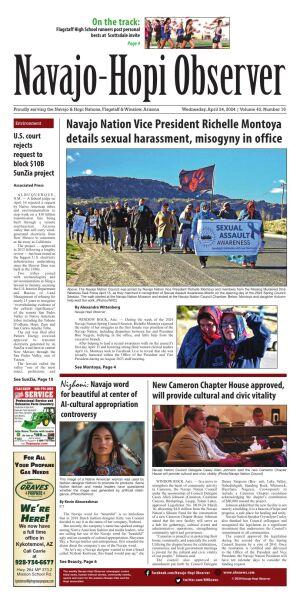Before the advent of pottery, metalwork, or even loom weaving, there was basketry — one of humanity’s earliest forms of artistic expression.
For many Southwest tribes, this ancient tradition has passed down through the ages, woven into the very fabric of their cultural heritage.
Hopi basket maker Kathryn "Kathy" Kooyahoema and Iva Casuse Honwynum, Hopi and Navajo, are two women who still inspire wonder and awe in the craft today, winning multiple awards and accolades.
Now, their contributions are being spotlighted in a new book titled “Woven from the Center: Native Basketry in the Southwest,” by Arizona State Museum Associate Curator Diane Dittemore.
The book also includes work of basket makers and weavers from the Zuni, Tohono O’odham, Akimel O’odham, Jicarilla Apache, Western Apache and Salt River Pima-Maricopa tribes.
Both Kooyahoema and Honwynum grew up and still live in Second Mesa on the Hopi reservation. While Kooyahoema has lived in the village of Shungopavi her whole life, Honwynum moved from Shungopavi to the outskirts, Iskasokpu, at the age of 8. She now owns Iskasokpu Gallery, where she sells her baskets and some jewelry.
Honwynum was 10 years old when she made her first piece, a small coil basket, instructed by her grandmother, Esther Honanie.
“After I finished it, she told me to take (it) to the shrine and pray that I will become a good basket weaver and run back home,” Honwynum said.
Kooyahoema didn’t make her first piece until she was in her 20’s, but she grew up watching her mother and family make baskets.
“My mother would take us kids out to the hot desert to pick yucca and galleta (curly mesquite grass) with her, I would watch her process the yucca and grass, (and) eventually the basket making,” Kooyahoema said. “All these processes were part of my teaching.”
As Kooyahoema got older, her mother and grandmother showed her how to start and make baskets. Kooyahoema continued the process and did further learning on her own. Today, she still picks and processes yucca and grass native to the area.
Honwynum uses yucca from the area and also travels an hour to collect it from Moencopi, near Tuba City. There, she also gets willow branches. She gathers three-leaf Suumac branches locally and sometimes travels to Dilkon. When she gathers, she makes sure to cut above the roots so the plants will grow back.
In general, on Second Mesa the Hopi weavers specialize in coil basketry — woven by wrapping bundles of plant material with yucca. Colors are usually white, yellow, green – natural yucca colors — with plant dyes making red and black colors. Katsina dolls, animals and geometric designs are implemented.
In Third Mesa, the Hopi weavers specialize in wicker basketry, making plaques, cradles and burden baskets by weaving flexible stems of local plants like rabbit brush, scrub sumac and arroyo willow, using a variety of colors and designs.
Women in First, Second and Third mesas all make plaited sifter baskets by plaiting yucca fibers to achieve many designs. These are what goods were carried in centuries ago and often used in ceremony.
In 2014, Honwynum created a new kind of basket while working as an artist in residence in Santa Fe, New Mexico. The basket, pootsaya — combines the coil method, poota, with the sifter method, tutsaya.
Honwynum said the pootsaya symbolizes bringing people together.
“We all need each other to make good things happen for our community,” she said. “Especially for the future of our children and the children yet to come. Not only for Hopi but for all people.
The innovative design has been featured extensively in magazines, videos and around the web. To this day, Honwynum and her niece whom she taught the technique are the only ones to make it.
Energy into the art
Both Honwynum and Kooyahoema don’t spend a lot of time designing their baskets and symbols ahead of time, but tend to go with the flow.
“I don’t design, I just make what comes to me and what I am feeling,” Honwynum said.
“There are no specific symbols that I focus on, it all depends on how I feel the day I'm going to start a new one,” Kooyahoema said. “I make katsina and animal figures on either flat or actual baskets.”
The laid-back approach doesn’t mean, however, that the women do not consider the work sacred.
“When I weave a basket, I have to put myself — my energy — into it,” Honwynum said. “Most of my work is things I was taught — our history, our ways of life – so they all relate to what I am creating. I think most artist have this, we all give a part of ourselves in our art work. Our elders tell us when you create something it’s usually a reflection of you. You make yourself.”
Honwynum’s designs depict agriculture, life and nature.
“When I make a basket, it’s with prayer,” she said. “This week I was making rain and snow symbols in my baskets — prayer for moisture so we can have a good harvest this year. We need all the moisture we can get. We have been in a drought for years and so far it’s looking good.”
Although both women have spent decades making baskets that can sometimes be sold for thousands, they admit mistakes are all part of the process.
“Of course I make mistakes, however, only I know where my mistakes are,” Kooyahoema joked.
Honwynum said like life, all art is not perfect.
“When I make a mistake in my work I try to fix it (but) sometimes if it’s way too far into the piece, I leave it,” Honwynum said. “Maybe it was meant to be made that way. So when we make a mistake we say, ‘that's the tuuvoyla,’ — meaning if it’s yours, you can identify the piece by this mark, in this case, mistake.”
Inspiration from family and beyond
Both Kooyahoema and Honwynum have other jobs to supplement their incomes. Honwynum has been working part time with the USDA National Agricultural Statistic Services for 17 years, interviewing farmers and ranchers for data that is often used for grant funding. Kooyahoema has worked at the Hopi Tribal courts.
Kooyahoema said her biggest inspiration is her mother and grandmother, who made huge baskets as their primary income.
"The elder basket weavers, who have all moved on, have always been my greatest inspirations. I thought they made the most perfect baskets. My baskets will never compare to theirs. They also helped me grow with their own teachings and encouragements."
Honwynum credits her grandmother and aunt for teaching her to weave as well as cook. She is inspired by all of the other Hopi baskets she sees, too.
“I have done research on many Hopi baskets, I am so amazed at how talented our people are,” she said. “There was so many different contemporary baskets that just looking at them inspired me to continue my Pootsaya basket creation.”
Both women have learned a lot of wisdom down the road along with their art.
“I feel that if you are gifted with any type of artistic talent, you will see it and pursue it,” Honwynum said. “I encourage you to accept the gift and go with it.”
Kooyahoema and Honwynum will be selling their wares along with a dozen other basket weavers from tribes around the southwest at the Basket Weaver Expo at the Arizona State Museum in Tucson, March 23.
The event is in conjunction with the launch of Dittemore’s book, “Woven from the Center: Native Basketry in the Southwest.” The basketry showcase and book signing will take place from 10 a.m. to 2 p.m. on the museum’s front lawn.
There will be free museum admission that day, with a chance to see the Woven Through Time: American Treasures of Native Basketry and Fiber Art exhibit.


